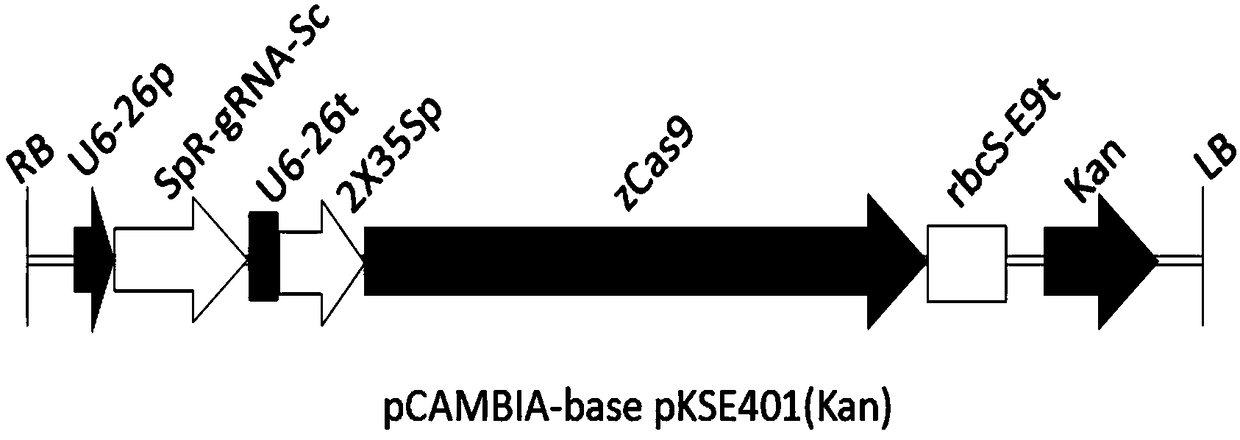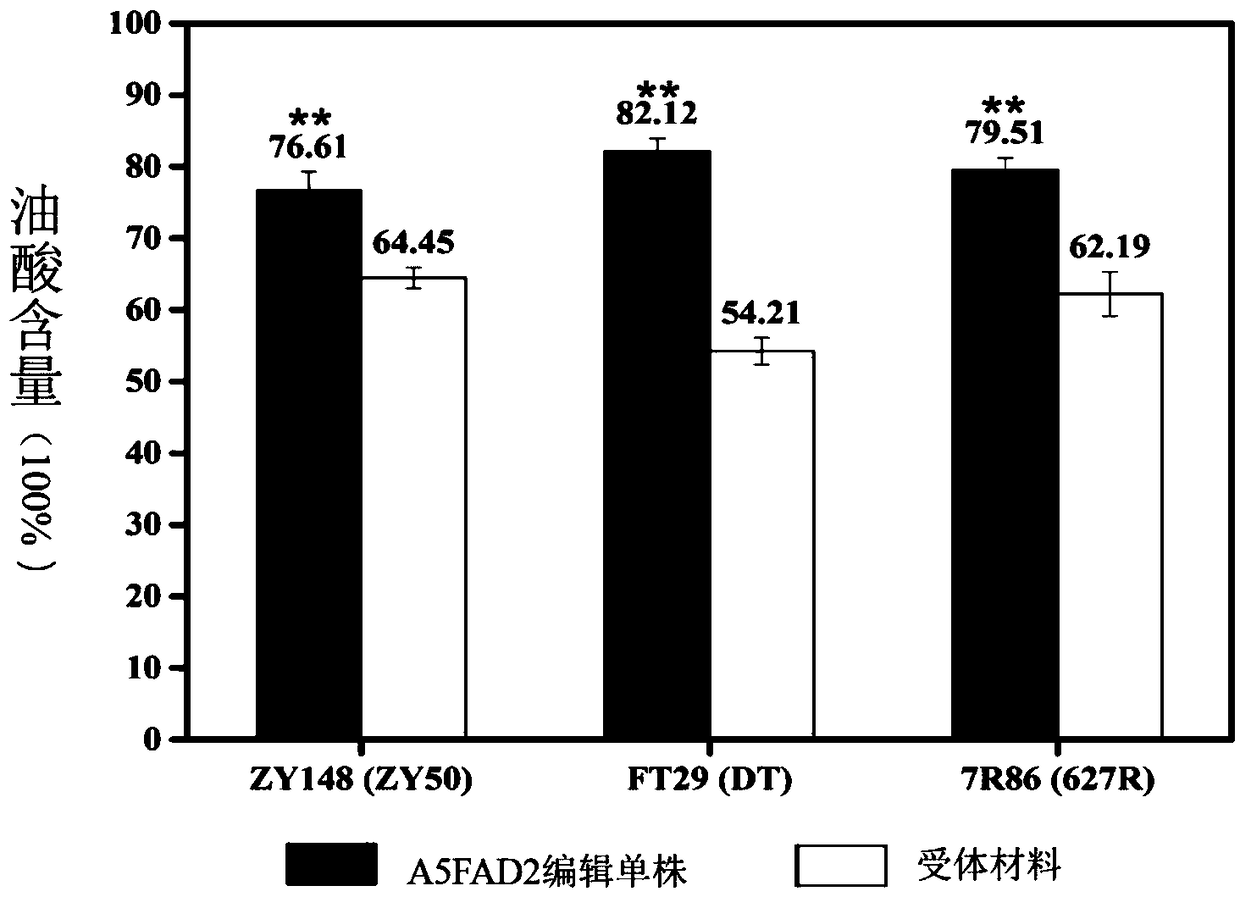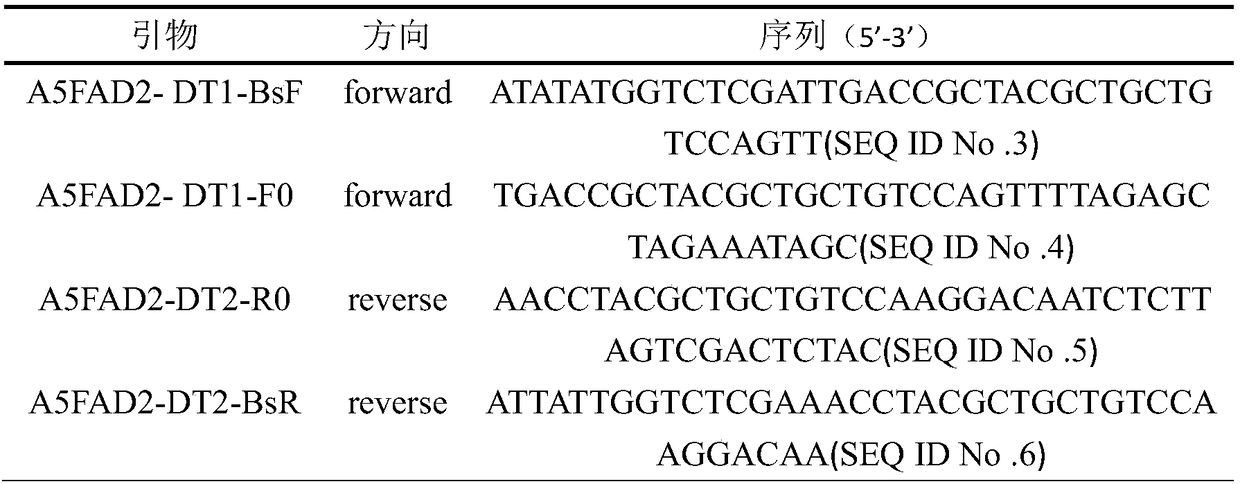Method for obtaining high oleic acid rapeseed by means of gene editing technology
A technology of gene editing and high oleic acid, applied in the field of plant genetic engineering, can solve the problem of undiscovered oleic acid in Brassica napus, and achieve the effects of good application prospects, improved oil content and high editing efficiency
- Summary
- Abstract
- Description
- Claims
- Application Information
AI Technical Summary
Problems solved by technology
Method used
Image
Examples
Embodiment 1
[0028] Embodiment 1: the acquisition of transgenic rape plant
[0029] Preparation of aseptic receptor materials: select plump and clean Brassica napus ZY50, 627R and DT, a total of 15 rapeseeds, soak in 76% ethanol for 3 minutes, then sterilize in 0.1% mercury liter for 15 minutes, rinse with sterile water 4 times , blot the excess water with sterile filter paper, inoculate on the germination medium, and culture in a cardboard box at 25-28°C for one week in the dark. Wherein the seed germination medium is: MS medium + agar powder 6.0-8.0 g / L, and the pH value is 5.8-6.0.
[0030] Donor strain culture: take out the strain tube stored at -80°C for a long time, put it on ice, scrape the surface of the frozen culture with an inoculation needle under aseptic conditions, and quickly streak the Agrobacterium adhered to the inoculation needle On the surface of LB agar plate containing 50mg / L kanamycin (Kan)+50mg / L gentamicin sulfate (Gen)+50mg / L rifampicin (Rfi). The inoculated aga...
Embodiment 2
[0036] Embodiment 2: the DNA extraction procedure of transformed plant
[0037] The DNA in the leaves of the T0 generation rape obtained in Example 1 was extracted by the CTAB sample method. Concretely include the following steps:
[0038] (1) Use a numbered 2mL centrifuge tube to take a small amount of young leaves of rapeseed;
[0039] (2) Place the sampled centrifuge tube on ice, open the lid and add clean steel balls and 100 μL 2% CTAB solution, put the lid on and grind it with a sample grinder adapter (TissulyserⅡ, QIAGEN) (28times / s, 30s );
[0040] (3) After the sample is ground, take out the centrifuge tube, open the lid, pour out the steel ball, and then add 300 μL CTAB solution;
[0041] (4) Place the centrifuge tube on the centrifuge box plate, place it in a constant temperature water bath at 55°C-60°C for 50min-60min, shake gently once every 10min, and place it on the workbench to cool to room temperature after the water bath;
[0042] (5) Add an equal volume (...
Embodiment 3
[0055] Example 3. Detection of the FAD2 gene editing site of a transgenic positive individual plant
[0056] Editing detection was performed on the genomic DNA of transgene-positive individual plants with target bands in both pairs of positive detection primers. Firstly, the target segment was amplified on the copy of the FAD2 gene in the transgene-positive individual plants using the primers (Table 3) whose PCR products partially overlapped each other. High-fidelity PMSF DNA polymerase (Phanta Max Super-Fidelity DNA Polymerase, Vazyme) was used to amplify the target segment, Two monoclonal antibodies that can inhibit its 5'→3' polymerase activity and 3'→5' exonuclease activity at room temperature are added to Max, which can perform highly specific hot-start PCR. The enzyme has 5'→3' polymerase activity and 3'→5' exonuclease activity, and the amplified product is blunt-ended. According to the PCR reaction preparation method in Table 4, the amplification of the target fragm...
PUM
 Login to View More
Login to View More Abstract
Description
Claims
Application Information
 Login to View More
Login to View More - R&D
- Intellectual Property
- Life Sciences
- Materials
- Tech Scout
- Unparalleled Data Quality
- Higher Quality Content
- 60% Fewer Hallucinations
Browse by: Latest US Patents, China's latest patents, Technical Efficacy Thesaurus, Application Domain, Technology Topic, Popular Technical Reports.
© 2025 PatSnap. All rights reserved.Legal|Privacy policy|Modern Slavery Act Transparency Statement|Sitemap|About US| Contact US: help@patsnap.com



